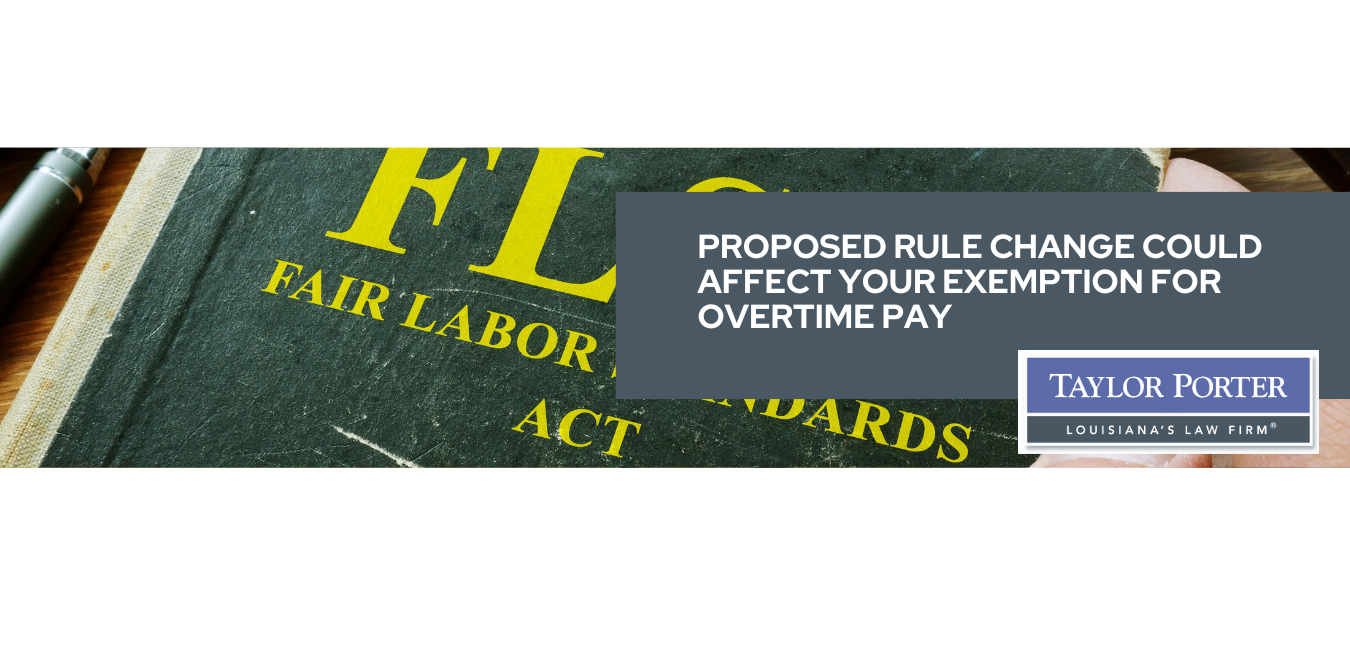Considerations for Making Beneficiary Designations for Life Insurance, Annuities and Retirement
Click here for PDF of article
By John F. McDermott
Partner, Taylor Porter
john.mcdermott@taylorporter.com
Only 44% of American adults have made a last will and testament. Major reasons given for failing to have a testament are that it is too complicated and that there are too many things to consider. Yet, almost everyone has designated the beneficiary of his life insurance policy or a retirement account. These policies and accounts can be significant assets and often comprise a major portion of an individual’s estate. When a policy is acquired or an account is opened, a beneficiary designation is made because it is required as part of the application. The designation is made perfunctorily, forgotten about, and too often receives no further consideration. Beneficiary designations need to be reviewed as an essential part of any estate plan. A perfect time to do so is when the testament is being prepared. An estate plan is not complete until the testament has been executed and beneficiary designations have been reviewed and revised as necessary.
All of the considerations that go into making testamentary bequests are relevant in making beneficiary designations. First and foremost is who is to receive the benefits. Is there more than one? If so, who is to receive what, in what portions, and in what priority? Next to consider is how the benefits should be transferred. Is the intended beneficiary capable of managing the assets? Are they impaired in any manner or subject to detrimental influence? What is the financial status of the beneficiary? Do they have creditors standing by? Is the intended beneficiary receiving governmental assistance with medical or living expenses? Is the beneficiary minor? Is the beneficiary a charity? Are there estate tax implications? The answers to these questions will dictate who is to receive and how they should receive benefits. Assuming these questions are answered in the course of preparing the testament, this article will discuss the issues involved in implementing them with beneficiary designations. The mechanics and considerations for making beneficiary designations are similar for life insurance policies, annuities, and retirement accounts. Therefore, consideration will be given first to life insurance policies and then to annuities and retirement accounts.
An application for a life insurance policy will include a beneficiary designation form that will permit the naming of one or more primary and secondary, or contingent, beneficiaries. Further, the policy will have provisions stating how proceeds will be distributed in the absence of a valid beneficiary designation. The beneficiary may be one or more natural persons, trusts, corporations, limited liability companies, partnerships, or a combination thereof. The beneficiary can also be the estate of the insured.
If one person is named as primary beneficiary, all proceeds will be paid to the beneficiary if he survives the insured. If more than one primary beneficiary is named, the portion to each must be stated and the portions must total 100%. If individual portions are not stated, then all named beneficiaries will be treated equally. However, the policy will contain provisions in case the stated portions do not total 100%, or if, for any reason, there is an extra portion. Some policies state the first named beneficiary will receive the extra portion. Other policies provide that the extra portion will be divided among the beneficiaries equally or in proportion to their stated portions.
If there are multiple principal beneficiaries, and one dies before the insured, the proceeds will be divided among the remaining beneficiaries. Policies differ on how this reallocation is made. Some policies will reallocate equally among the remaining beneficiaries. Other policies will reallocate proportionately based on the share designated to each named beneficiary. It is important to know what the policy provides, and, if it is not what is desired, specific instructions need to be provided to the company. Most companies will allow such modifications to be made. However, nothing will be distributed to contingent beneficiaries if any of the principal beneficiaries survive.
It is common for spouses to name each other as primary beneficiary and children as contingent beneficiaries. If both spouses have made similar designations, it is virtually assured that the primary designation will be effective for only one of the spouses’ policies, and that being the policy of the first spouse to die. Of course, it is advisable that the surviving spouse revisit the beneficiary designations after the spouses’ death, but this does not always happen. In such cases the contingent beneficiary will apply.
When children are named as beneficiaries, they can be designated individually by name, or as a class, such as “all my children.” Naming children individually allows for allocating different shares among them. If designated by class, all will be treated equally.
As discussed above, the share of a deceased named beneficiary gets reallocated to the other named beneficiaries. This may not be the intended result when children are the beneficiaries. Under Louisiana law, we understand the principle of representation that takes effect ad infinitum in the direct line of descendants to cause legacies or inheritance to flow to children of a deceased heir or legatee. Representation does not apply in the contractual world of insurance policies. If a child is named as beneficiary, and, if it is the intent that the child’s share should go to his child or children, it is necessary to make a “per stirpes” beneficiary designation. The term “per stirpes” is similar to the Louisiana term “by roots.” It means that the children of a named beneficiary are to receive the share allocated to the beneficiary if the beneficiary does not survive the insured. Most beneficiary designation forms contain instructions on how to make a per stirpes designation. Sometimes there is a box to check; sometimes the term “per stirpes” must be written immediately after the beneficiary’s name. It is important to understand that a per stirpes designation is not the usual policy provision. If it is desired, it must be stated.
If it is desirable to create a trust for testamentary bequests, it probably makes sense to use the same trust if the beneficiary thereof is to be the beneficiary of an insurance policy or retirement account. If a trust is to be designated as beneficiary, care needs to be given to accurately name or describe the trust. In the case of an inter vivos trust, most companies will require the name of the trust, the date of the trust, and possibly the name of the trustee. They
might also require a copy of the trust instrument. If a testamentary trust is designated, it is usually sufficient to simply make reference to the testament that created the trust. A testamentary trust designation may be as simple as “the testamentary trust per the Last Will and Testament of Joe Smith.” Because testaments are subject to revision, try to avoid describing the testamentary trust by reference to the date of the testament.
The beneficiary designation form cannot anticipate nor provide for all variations of possible designations. If a designation is not accommodated by the form, the company will allow a statement to be attached making the desired designation. If a statement is to be used, it should be submitted to the company for review. Most companies will cooperate with reviewing and advising on language to be used to accomplish the desired designation. The insurance agent can assist with this process.
Obtaining confirmation of any change is also important. I had a case where we asked the agent to confirm a change that had been made. The agent checked and responded saying the company had acknowledged receipt of the change. A second-hand verbal acknowledgment is not sufficient. Adequate written confirmation consists of seeing the beneficiary designation of record with the company. When we finally received a copy of the company’s records, it was not correct. The company had processed a change of ownership but had failed to process a change of beneficiary that was submitted at the same time. Because we checked, we were able to make appropriate corrections.
The same considerations discussed above apply when making contingent beneficiary designations. If no valid primary or contingent beneficiary designation is in effect at the time of death, the policy contains default provisions to determine who will receive the proceeds. Again, the policies vary. A common default provision is to distribute, first, to the surviving spouse, if any, then to children, if any, then to the insured’s estate. Variations might change the order of priority, leave out or add to the list, or stipulate per stirpes. The only way to know for sure is to read the policy.
It seems simple enough that proceeds would be paid to a named beneficiary who survives the insured. The normal expectation is that the beneficiary’s rights to receive the proceeds vests at the moment of the insured’s death. This is not necessarily the case. Some policies require the beneficiary to survive the insured for a period of time. One policy provided that unless proceeds were sooner distributed to a living beneficiary, the proceeds would be paid only if the beneficiary survived the insured by thirty days. In other words, the named beneficiary would be treated as having predeceased the insured if the beneficiary died within thirty days without having applied for and without having actually received the proceeds. In such a case, the proceeds would be paid to the other primary beneficiaries, or, if none, to the contingent beneficiary. If the insured is not the owner of the policy, there is an unexpected gift tax consequence if the owner is not named as the beneficiary. The proceeds payable to anyone other than the owner will be treated as a gift for tax purposes. The gift and estate tax consequences imposed on the owner of the policy need to be recognized and considered when naming someone else as the beneficiary.
Although divorce will automatically revoke a testamentary bequest made to a spouse, such is not the case with beneficiary designations. It is important to review and revise all beneficiary designations at the time of or following a divorce. Beneficiary designations for annuities and retirement accounts are subject to the same considerations discussed above for insurance policies plus a few others. Although divorce does not automatically nullify retirement account beneficiary designations, marriage might. Marriage might invalidate a beneficiary designation on any retirement account that is subject to ERISA because ERISA requires a spouse to be the primary beneficiary. If a beneficiary is named prior to marriage, and the account holder later marries, the old beneficiary designation will be null, and the new spouse will be deemed to be the beneficiary.
Special consideration needs to be given when designating a trust as the beneficiary of a retirement account. An individual named as the beneficiary of a retirement account has the opportunity to continue the tax deferral benefits of the account. Minimum annual distributions will be required based upon the age of the beneficiary. But, after taking the required minimum distribution, the remainder of the account can continue tax deferred until eventually distributed. If a trust is named the beneficiary, the entire account will be required to be distributed within five years of the account owners’ death. The result can be avoided, and the trust can qualify to receive the same treatment as an individual if the trust is a special conduit trust. Check the requirements for a conduit trust before name a trust as beneficiary of a retirement account.
When you review retirement accounts also ask about and review health savings accounts. Health savings accounts are not a prevalent as retirement accounts, but they also have beneficiary designations.
Whether you prepare your last will and testament or that of a client, you have not finished planning the succession of assets until you have reviewed the beneficiary designations on life insurance policies, annuities, retirement accounts, and health savings accounts.
About John McDermott: John F. McDermott is a partner in the law firm of Taylor, Porter, Brooks & Phillips, LLP. He has practiced in the area of taxation and estate planning for more than 30 years. He is a Board Certified Tax Law Specialist, and is currently serving on the Internal Revenue Service Advisory Counsel.
This website is for general information purposes only. Information posted is not intended to be legal advice. For more information, please see our Disclaimer message.
See how we can help. Contact us today
8th Floor • 450 Laurel Street • Baton Rouge, LA 70801 • 225-387-3221
- Disclaimer
- © Taylor, Porter, Brooks & Phillips L.L.P. All rights reserved.






